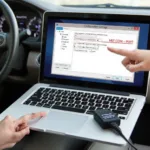The Konnwei OBD2 pin configuration is crucial for anyone using an OBD2 scanner. Knowing which pin does what allows for a deeper understanding of how your scanner communicates with your vehicle’s onboard computer. This article will explore the Konnwei OBD2 pinout, explaining the function of each pin and addressing common questions.
Are you struggling with iPhone OBD2 compatibility issues? Check out our helpful guide on iphone obd2 not supported.
Decoding the Konnwei OBD2 Pinout
The OBD2 connector, a standardized 16-pin port, is the gateway to your car’s diagnostic data. Each pin in this connector has a specific function, facilitating communication between the OBD2 scanner and the vehicle’s various control modules. While the pin configuration is standardized, understanding their roles helps troubleshoot connection problems and interpret data more effectively.
Power and Ground: The Foundation of Communication
Pins 4 and 5 are essential for powering the OBD2 scanner. Pin 4 is the chassis ground, providing a return path for electrical current. Pin 5 is the signal ground, ensuring a stable reference point for voltage measurements. Pin 16 provides battery power to the scanner, enabling it to operate independently of the vehicle’s ignition.
Communication Lines: The Language of Diagnostics
Pins 2, 6, 7, 10, 14, and 15 are dedicated to communication. Pin 2 is the J1850 Bus+ line used in some Chrysler, Ford, and GM vehicles. Pin 6 is the CAN High (J-2284) line found in most modern vehicles. Pin 7 is the K-Line (ISO 9141-2) used in many European and Asian vehicles. Pin 10 is the J1850 Bus- line. Pin 14 is the CAN Low (J-2284) line, completing the CAN bus circuit. Pin 15 is the L-Line (ISO 9141-2) for bidirectional communication.
For a comprehensive review of the KW808 scanner, visit our obd2 scanner kw808 page.
Manufacturer Specific Pins: Tailored Functionality
Pins 1, 3, 8, 9, 11, 12, and 13 are manufacturer-specific, meaning their functions vary depending on the vehicle’s make and model. These pins might be used for additional communication protocols, proprietary diagnostics, or other specialized functions.
Frequently Asked Questions about Konnwei OBD2 Pins
What if my Konnwei scanner doesn’t connect? First, verify the OBD2 connector’s power and ground connections. Then, ensure the scanner and vehicle protocols are compatible.
Can I damage my car by probing the OBD2 pins? Avoid directly probing the pins with sharp objects or applying excessive voltage. Use a suitable OBD2 adapter or multimeter for testing.
Are all Konnwei OBD2 pins used in every vehicle? No, the use of specific pins depends on the vehicle’s communication protocols and manufacturer-specific implementations.
Where can I find my car’s specific Konnwei OBD2 pinout? Consult your vehicle’s service manual or online resources for specific pin assignments.
Do all Konnwei scanners use the same pin configuration? Konnwei scanners, along with other OBD2 scanners, adhere to the standard 16-pin configuration.
Conclusion
Understanding the Konnwei obd2 pin configuration is essential for effective vehicle diagnostics. This knowledge allows you to troubleshoot connectivity issues, interpret data accurately, and gain a deeper understanding of your vehicle’s systems. By familiarizing yourself with the function of each pin, you can unlock the full potential of your Konnwei OBD2 scanner. Looking for more insights into Konnwei scanners? Check out our konnwei bluetooth obd2 scanner review.
Interested in OBD2 apps for Ford diesel vehicles? Explore our ford diesel obd2 app resource.
Need assistance? Contact us via WhatsApp: +1(641)206-8880, Email: cardiagtechworkshop@gmail.com or visit us at 789 Elm Street, San Francisco, CA 94102, USA. We have a 24/7 customer support team.


